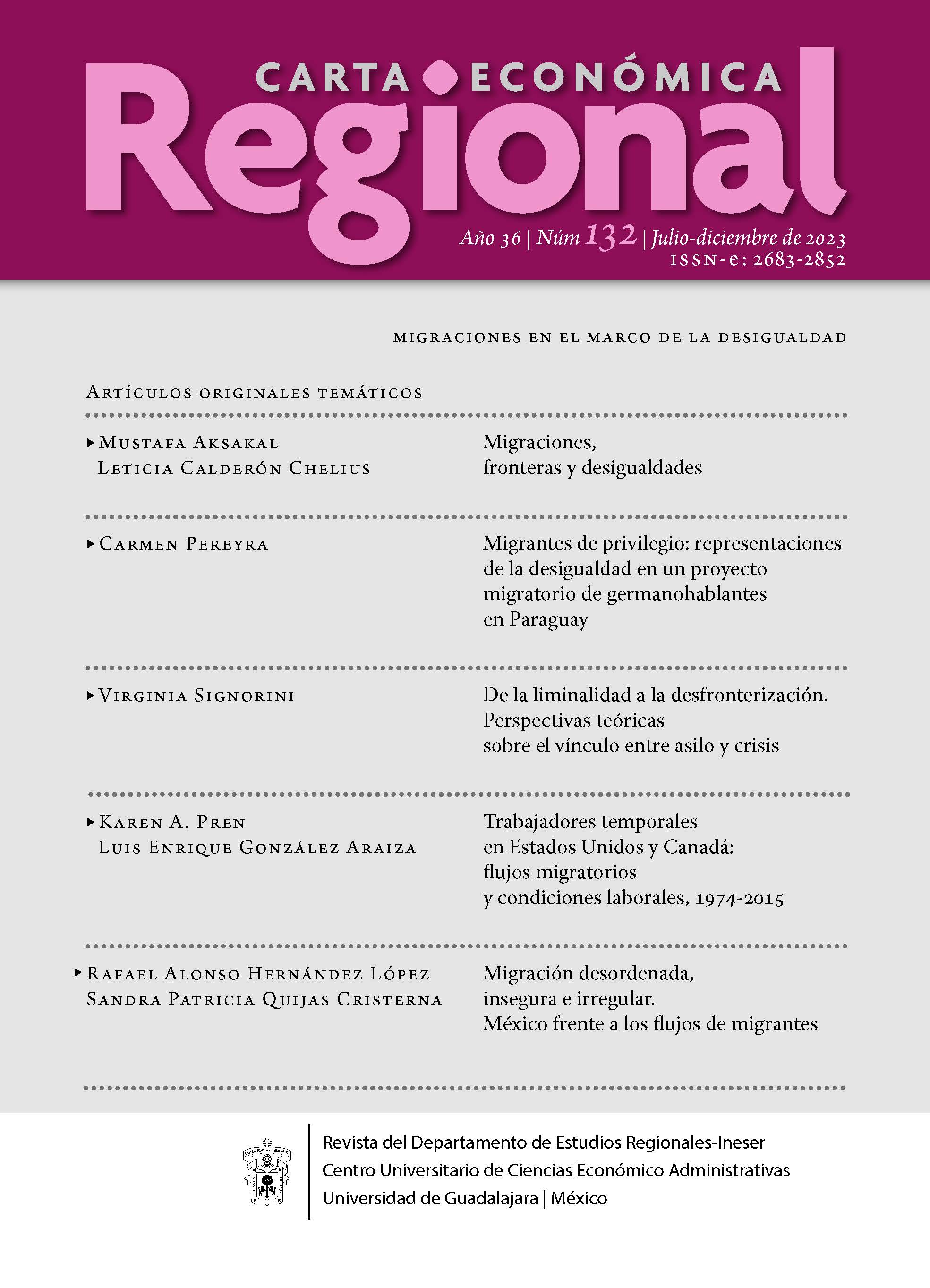Migraciones, fronteras y desigualdades
Resumen
La introducción de este segundo número pretende hacer un acercamiento teórico al tema en el que se respondan, entre otras, las siguientes preguntas: ¿cuáles son las reflexiones teóricas clásicas en las ciencias sociales sobre migraciones? y desigualdades?, ¿qué papel desempeñan en ello las perspectivas latinoamericanas? y ¿cuáles planteamientos y conceptos pueden facilitar la indagación teórica de los procesos relacionados con las migraciones actuales en América Latina?Citas
Aksakal, M. (2020). Warum verlassen Menschen ihre Lebensorte? Ein Überblick über Ansätze zur Erklärung der Initiierung von Wanderung. En Faist, T. (ed.), Sozialwissenschaftliche Ein- führungen. Soziologie der Migration: Eine systematische Einführung (pp. 97-124). Berlín: De Gr uy ter.
Baran, P. A. y Sweezy, P. M. (enero de 1966). Monopoly capital. An essay on the American Economic and social order. London: Monthly Review Press.
Battistella, G. (2017). Temporary labour migration: a flawed system in need of reform. En Carrera, D., Geddes, A., Guild, E. y Stefan, M. (eds.), Pathways towards legal migration into the eu. Reappraising concepts, trajectories and policies (pp. 15-19). Bruselas: Centre for European Policy Studies.
Blouin, C. y Zamora-Gómez, C. (2022). Institutional and social xenophobia towards Venezuelan migrants in the context of a racialized country: the case of Peru. En Herrera, G. y Gómez, C. (eds.), Migration in South America (pp. 169-190). Cham, Switzerland: Springer.
Burawoy, M. (1976). The functions and reproduction of migrant labor: comparative materials from Southern Africa and the United States. American Journal of Sociology, 81(5), 1050-1087.
Cardoso, F. y Falleto, E. (1979). Dependency and development in Latin America. Berkeley, CA: University of California Press.
Castles, S. (2011). Migration, crisis, and the global labour market. Globalizations, 8(3), 311-324.
Conti, L. y Nejamkis, L. (2023). Editorial. Carta Económica Regional,35(131), 7-10.
Delgado-Wise, R ., Chávez-Elorza, M. G. y Gaspar-Olvera, S. (2021). La migración mexicana altamente calificada de cara al siglo xxi: problemática y desafíos. Ciudad de México: Consejo Nacional de Ciencia y Tecnología (Conacyt).
Dos Santos, T. (1970). The structure of dependence. The American Economic Review,60(2), 231- 236.
Faist, T. (2000). The volume and dynamics of international migration and transnational social spaces.Oxford, ru: Clarendon Press.
Faist, T. (ed.) (2020). Wege zu einer transnationalen Methodologie. En Soziologie der Migration.Eine systematische Einführung (pp. 237-260). Berlin: De Gruyter.
FitzGerald, D. S. (2022). The sociology of international migration. En Brettell, C. y Hollifield, J. F. (eds.), Migration theory: talking across disciplines (pp. 160-193). London: Routledge.
Frank, A. G. (1967). Capitalism and underdevelopment in Latin America. London: Monthly Re- view Press.
Fröbel, V., Heinrichs, J. y Kreye, O. (1980). The new international division of labour. Structural unem-
| 15Migraciones, fronteras y desigualdades | | Mustafa Aksakal, Leticia Calderón Cheliusployment in industrialised countries and industrialisation in developing countries. Cambridge, ru: Cambridge University Press.
Furtado, C. (1974). Underdevelopment and dependence: the fundamental connection. Centre of Latin American Studies, Working Papers 17.
Gerhards, J. y Kämpfer, S. (2017). Symbolische Grenzen und die Grenzarbeit von Migrantinnen und Migranten. Zeitschrift für Soziologie, 46(5), 303-325.
Hernández-León, R ., Sandoval-Hernández, E. y Muñoz-Paniagua, L. E. (2022). Bringing back the Bracero Program: the migration industry in the recruitment of H -2 visa workers. En Sauce- do, L. y Rodriguez, R . M. (eds.), Race, gender and contemporary international labor migration regimes 21st-century coolies? (pp. 35-62). Cheltenham, ru: Edward Elgar Publishing.
Lamont, M. y Molnár, V. (2002). The study of boundaries in the social sciences. Annual Review of Sociology,28(1), 167-195.
Manning, P. y Trimmer, T. (2020). Migration in world history ( 3rd ed.). United Kingdom: Taylor & Francis.
Marini, R . M (1973). Dialéctica de la dependencia. México: Ediciones Era.
Massey, D. S., Arango, J., Hugo, G., Kouaouci, A., Pellegrino, A. y Taylor, J. E. (1998). Worlds in motion: understanding international migration at the end of the millennium. Oxford: Clarendon Press.
Meyer, J. W., Boli, J., Thomas, G. M. y Ramirez, F. O. (1997). World society and the nation‐state.American Journal of Sociology, 103(1), 144-181.
Miller, T. (2019). Empire of borders. The expansion of the us border around the world. New York, London: Verso.
Morawska, E. (2012). Historical-structural models of international migration. En Martiniello, M. y Rath, J. (eds.), An introduction to international migration studies: European perspectives ( pp. 57-78). Amsterdam: Amsterdam University Press.
Nejamkis, L., Conti, L. y Aksakal, M. (eds.) (2021). (Re)pensando el vínculo entre migración y crisis.Perspectivas desde América Latina y Europa. Buenos Aires: clacso.
Ostrand, N. y Statham, P. (2021). ‹Street-level› agents operating beyond ‹remote control›: how overseas liaison officers and foreign state officials shape uk extraterritorial migration mana- gement. Journal of Ethnic and Migration Studies,47(1), 25-45.
Pécoud, A. (2021). Narrating an ideal migration world? An analysis of the Global Compact for Safe, Orderly and Regular Migration. Third World Quarterly, 42(1), 16-33.
Pitkänen, P., Hayakawa, T., Aksakal, M., Schmidt, K. y Rajan, S. I. (eds.) (2017). Temporary mi-gration, transformation and development: evidence from Europe and Asia. London: Routledge
Aquellos autores/as que tengan publicaciones con esta revista, aceptan los términos siguientes:
- Los autores/as conservarán sus derechos de autor y garantizarán a la revista el derecho de primera publicación de su obra, el cuál estará simultáneamente sujeto a la Licencia de reconocimiento de Creative Commons que permite a terceros compartir la obra siempre que se indique su autor y su primera publicación esta revista.
- Los autores/as podrán adoptar otros acuerdos de licencia no exclusiva de distribución de la versión de la obra publicada (p. ej.: depositarla en un archivo telemático institucional o publicarla en un volumen monográfico) siempre que se indique la publicación inicial en esta revista.
- Se permite y recomienda a los autores/as difundir su obra a través de Internet (p. ej.: en archivos telemáticos institucionales o en su página web) déspues de que su trabajo sea publicado, lo cual puede producir intercambios interesantes y aumentar las citas de la obra publicada. (Véase El efecto del acceso abierto).


_(1).jpg)






.png)



